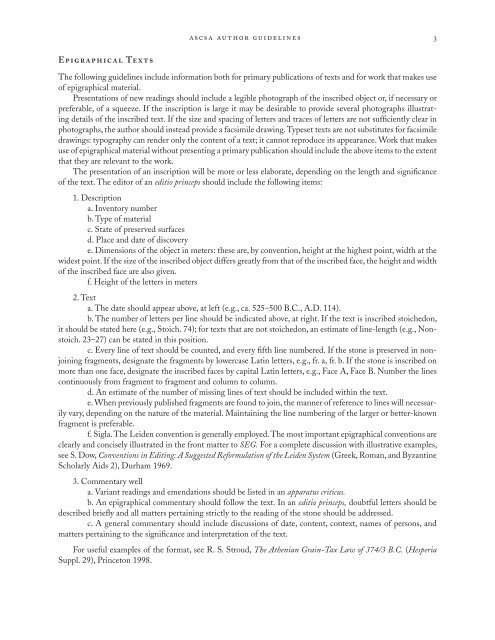Guidelines for Authors - The American School of Classical Studies at ...
Guidelines for Authors - The American School of Classical Studies at ...
Guidelines for Authors - The American School of Classical Studies at ...
Create successful ePaper yourself
Turn your PDF publications into a flip-book with our unique Google optimized e-Paper software.
ascsa author guidelines 3<br />
Epigraphical Texts<br />
<strong>The</strong> following guidelines include in<strong>for</strong>m<strong>at</strong>ion both <strong>for</strong> primary public<strong>at</strong>ions <strong>of</strong> texts and <strong>for</strong> work th<strong>at</strong> makes use<br />
<strong>of</strong> epigraphical m<strong>at</strong>erial.<br />
Present<strong>at</strong>ions <strong>of</strong> new readings should include a legible photograph <strong>of</strong> the inscribed object or, if necessary or<br />
preferable, <strong>of</strong> a squeeze. If the inscription is large it may be desirable to provide several photographs illustr<strong>at</strong>ing<br />
details <strong>of</strong> the inscribed text. If the size and spacing <strong>of</strong> letters and traces <strong>of</strong> letters are not sufficiently clear in<br />
photographs, the author should instead provide a facsimile drawing. Typeset texts are not substitutes <strong>for</strong> facsimile<br />
drawings: typography can render only the content <strong>of</strong> a text; it cannot reproduce its appearance. Work th<strong>at</strong> makes<br />
use <strong>of</strong> epigraphical m<strong>at</strong>erial without presenting a primary public<strong>at</strong>ion should include the above items to the extent<br />
th<strong>at</strong> they are relevant to the work.<br />
<strong>The</strong> present<strong>at</strong>ion <strong>of</strong> an inscription will be more or less elabor<strong>at</strong>e, depending on the length and significance<br />
<strong>of</strong> the text. <strong>The</strong> editor <strong>of</strong> an editio princeps should include the following items:<br />
1. Description<br />
a. Inventory number<br />
b. Type <strong>of</strong> m<strong>at</strong>erial<br />
c. St<strong>at</strong>e <strong>of</strong> preserved surfaces<br />
d. Place and d<strong>at</strong>e <strong>of</strong> discovery<br />
e. Dimensions <strong>of</strong> the object in meters: these are, by convention, height <strong>at</strong> the highest point, width <strong>at</strong> the<br />
widest point. If the size <strong>of</strong> the inscribed object differs gre<strong>at</strong>ly from th<strong>at</strong> <strong>of</strong> the inscribed face, the height and width<br />
<strong>of</strong> the inscribed face are also given.<br />
f. Height <strong>of</strong> the letters in meters<br />
2. Text<br />
a. <strong>The</strong> d<strong>at</strong>e should appear above, <strong>at</strong> left (e.g., ca. 525–500 B.C., A.D. 114).<br />
b. <strong>The</strong> number <strong>of</strong> letters per line should be indic<strong>at</strong>ed above, <strong>at</strong> right. If the text is inscribed stoichedon,<br />
it should be st<strong>at</strong>ed here (e.g., Stoich. 74); <strong>for</strong> texts th<strong>at</strong> are not stoichedon, an estim<strong>at</strong>e <strong>of</strong> line-length (e.g., Nonstoich.<br />
23–27) can be st<strong>at</strong>ed in this position.<br />
c. Every line <strong>of</strong> text should be counted, and every fifth line numbered. If the stone is preserved in nonjoining<br />
fragments, design<strong>at</strong>e the fragments by lowercase L<strong>at</strong>in letters, e.g., fr. a, fr. b. If the stone is inscribed on<br />
more than one face, design<strong>at</strong>e the inscribed faces by capital L<strong>at</strong>in letters, e.g., Face A, Face B. Number the lines<br />
continuously from fragment to fragment and column to column.<br />
d. An estim<strong>at</strong>e <strong>of</strong> the number <strong>of</strong> missing lines <strong>of</strong> text should be included within the text.<br />
e. When previously published fragments are found to join, the manner <strong>of</strong> reference to lines will necessarily<br />
vary, depending on the n<strong>at</strong>ure <strong>of</strong> the m<strong>at</strong>erial. Maintaining the line numbering <strong>of</strong> the larger or better-known<br />
fragment is preferable.<br />
f. Sigla. <strong>The</strong> Leiden convention is generally employed. <strong>The</strong> most important epigraphical conventions are<br />
clearly and concisely illustr<strong>at</strong>ed in the front m<strong>at</strong>ter to SEG. For a complete discussion with illustr<strong>at</strong>ive examples,<br />
see S. Dow, Conventions in Editing: A Suggested Re<strong>for</strong>mul<strong>at</strong>ion <strong>of</strong> the Leiden System (Greek, Roman, and Byzantine<br />
Scholarly Aids 2), Durham 1969.<br />
3. Commentary well<br />
a. Variant readings and emend<strong>at</strong>ions should be listed in an appar<strong>at</strong>us criticus.<br />
b. An epigraphical commentary should follow the text. In an editio princeps, doubtful letters should be<br />
described briefly and all m<strong>at</strong>ters pertaining strictly to the reading <strong>of</strong> the stone should be addressed.<br />
c. A general commentary should include discussions <strong>of</strong> d<strong>at</strong>e, content, context, names <strong>of</strong> persons, and<br />
m<strong>at</strong>ters pertaining to the significance and interpret<strong>at</strong>ion <strong>of</strong> the text.<br />
For useful examples <strong>of</strong> the <strong>for</strong>m<strong>at</strong>, see R. S. Stroud, <strong>The</strong> Athenian Grain-Tax Law <strong>of</strong> 374/3 B.C. (Hesperia<br />
Suppl. 29), Princeton 1998.
















